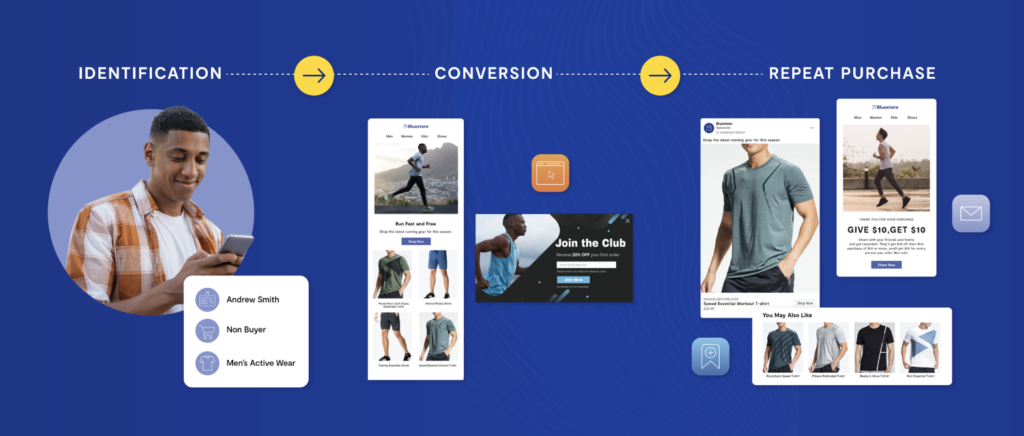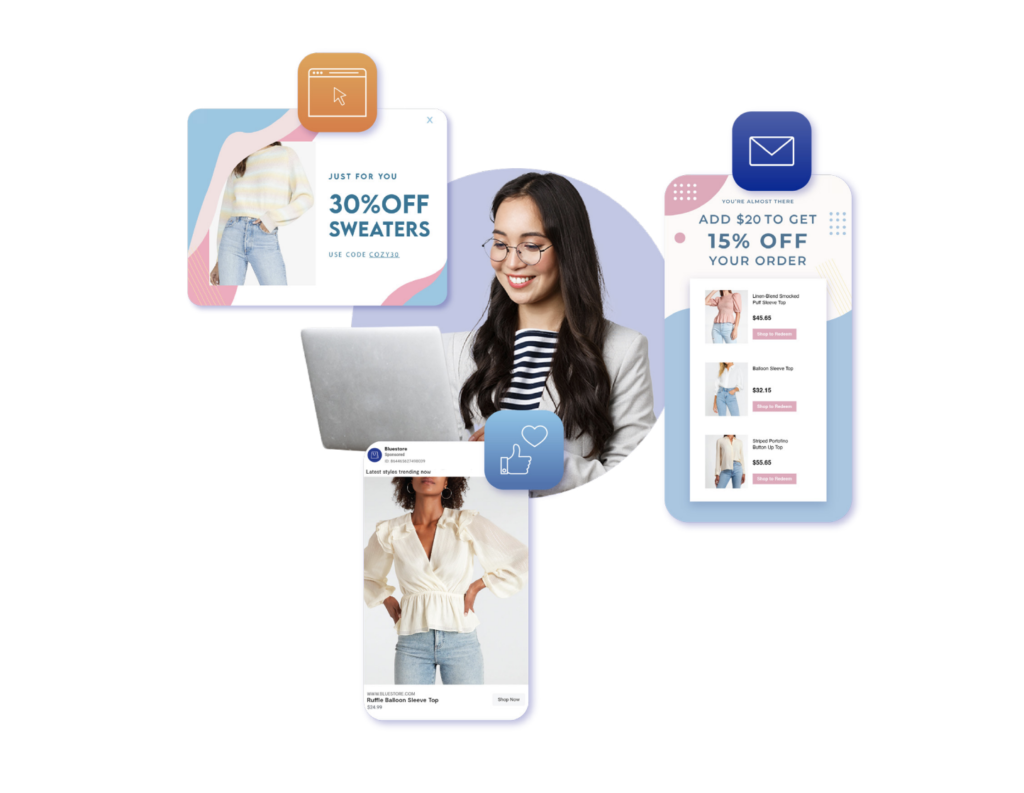The Advanced Guide to Customer Lifecycle Marketing
The key to long-term revenue is continuous customer engagement. The name of the game is retention and loyalty: New customers are silver – returning customers are gold.
In the digital landscape, marketers need to create a sense of accessibility and responsiveness around their brand along every step of the customer journey.
Customer relationship management (CRM) is crucial, and like any relationship, the one you have with your customers takes time, care and attention to grow and flourish.
To nurture that relationship you need an integrated, highly personalized customer lifecycle marketing strategy that attracts, converts and retains.
[Download our 2022 Retail Ecommerce Benchmark Report]
What is Customer Lifecycle Marketing?
Customer lifecycle marketing (CLM) is an umbrella term that embraces all the different strategies you use to attract, guide, convert and retain customers to your brand. The goal of CLM is to accompany customers along every step of their unique journey.
The customer lifecycle and the customer journey sit on opposite sides of the same coin.
- Customer journey refers to the customer’s experience of your brand, from the very first ad they see through their first conversion and (hopefully) beyond.
- The customer lifecycle is your side of the coin, where you do all the work to keep your brand front and center in a customer’s mind throughout their lifecycle.
If you’re not tailoring your CLM strategies to the particular stages of your customer journey, chances are very good your CLM is going to have major gaps where a lot of customers or would-be customers are falling through, and falling away.
The Three Stages of the Customer Lifecycle

Below are the three stages of a customer’s lifecycle with any brand. Keep in mind that while for some customers the journey is linear, it’s far more common to cycle through stages more than once. Successful CLM strategies center this fact by focusing on engagement at every stage.
1. Identification
The identification stage is all about gathering identifiers of new shoppers to begin building an effective targeting method a.
- Reach new shoppers across channels
- Capture new shopper identifiers to build shopper context
- Discover through their browsing behavior and shopper data how to personalize communications
2. Conversion
After you’ve identified your new shoppers you can begin building a strategy designed for them with personalized campaigns that will convert. There are a few ways you can reach new visitors with personalized communications:
- Trigger campaigns across channels based on your shopper’s browsing behavior, like abandoning a cart or product page
- Recommend products that your new shopper is likely to buy, based on what they’re engaging with in your product catalog and what similar shoppers have purchased
- Nurture your new visitors to their first purchase
3. Loyalty and Repeat Purchase
After your shopper has made their first purchase, it’s time to begin your post-purchase flow and subsequent campaigns, designed to bring them back again and again. There are a few stages of loyalty and repeat purchases that will drive revenue:
- Deeper and enhanced levels of personalization in real-time based on continuous feedback loops from your shopper identifiers
- Personalized emails that move beyond the standard abandoned cart reminder, to address concerns or possibly to upsell or cross-sell
- Ask for feedback via surveys or purchase reviews
- Surface new opportunities to buy through products that your shopper will be interested in next to cross-sell
- Engage your shopper in new loyalty programs and nurture streams designed with them i mind as new members of your shopper community
Customer Lifecycle Marketing Strategies
The goal of Customer Lifecycle Marketing is engagement, loyalty, a better ROI and increased revenue. To do all of this, you need to provide the most value possible at every stage of the customer journey.
Customers need to feel that your brand is worth their time, attention and money. Here are some key CLM strategies to create and maintain throughout your customer lifecycle.
Engagement
How you begin your relationship with prospective customers matters. Without successfully identifying new shoppers, you won’t be armed with the data you need to convert. And engaging with previous buyers increases customer retention and loyalty – which translates into continuous profit. Data collected by Gartner indicates that almost 80% of a company’s future profits will come from just 20% of its existing customer base.
Engagement can take a lot of different forms and is a useful strategy to enact at every stage of the customer lifecycle. This looks like:
- Welcome email sequences
- Strong personalized, behavioral triggers
- High-value website and mobile content
- Responsive social media
Responsive cross-channel engagement has helped fitness lifestyle brand NOBULL to orchestrate cross-channel communication to meet each shopper with personalized communications and ads on paid media.
This is an effective tool to engage with both prospective and returning customers, letting brands like NOBULL engage throughout the customer lifecycle, and not just at the start.
Personalization
Personalization raises engagement across channels and throughout every stage of the lifecycle. The key to successfully implementing this strategy is in-depth data culled from an extensive lifecycle analysis. This data yields multiple paths customers may take on their journey, giving you the opportunity to craft messages targeted to those precise touch points.
Granular data helps brands like Lane Bryant create a more intelligent and responsive ecommerce personalization experience.
By focusing on consistent personalized cross-channel messaging, incentivizing visits and improving onsite email capture, Lane Bryant saw a better than 70% lift in conversions simply by focusing on customer lifecycle personalization.
Browse, Product and Cart Abandonment
Browse abandonment is something every business faces, leading many brands to assume a “that’s just how it is” attitude toward it. But it’s crucial not to overlook browse abandonment as simply a fact of doing business. After all, prospective customers come to your website or ecommerce site for a reason. Why not do everything you can to capitalize on their interest and guide them toward conversion?
Browse abandonment strategies can look like:
- Personalized abandonment emails
- Live on-site chat options
- Product demos and customer reviews
Cross-Selling
After conversion, your next goal is retention. Cross-selling is critical in your CLM strategy.
Cross-selling is familiar to anyone who’s ever shopped with online retailers. “Frequently bought together” recommendations, both on the site and as follow-up emails, are a common cross-selling technique. This strategy offers products or services that work with or support previous purchases.
Further cross-selling strategies include:
- Segmented post-conversion email sequences featuring related products
- Personalized SMS campaigns promoting new versions of previous purchases
- Incentivizing further conversion with exclusive previews of premium services, to “try before you buy.”
Replenishment
With the rise of online shopping, replenishment marketing has also grown in popularity – and necessity. Customers have in fact come to rely on personalized reminders to refill everything from prescription medicines to mascara. If you’re not offering these personalized replenishment messages, you’ve got a major gap in your CLM strategy.
Predictive modeling will forecast more accurately when a specific customer needs to replenish a specific item. It does this by utilizing customer lifecycle data to predict how often individuals or segments of customers will need to reorder.
A perfect example is paper towels. A single-person household may only replenish their paper towels twice a month. A household with two young children may restock every week. Implementing a modeling system that tracks purchase history and frequency to create personalized reminder emails or SMS messages accordingly provides more value than a model that averages out monthly use across the board for all customers.
Loyalty Programs
Loyalty programs encourage repeat business through incentives, rewards, sneak peeks, special sales offers and more. Some programs convey a sense of exclusivity, others encourage a bit of competition or rely on limited-time offers.
Which tactic works for your brand depends on a keen understanding of your customers. Effective loyalty programs, like every other CLM strategy, all revolve around accurate personalization.
New York & Company, a fashion retailer, used a private credit card program to issue awards to two tiers of customers. Membership to each tier was exclusive to shoppers who spent more than a given amount per year, and rewards came in the form of gift cards or a 5% or 10% back on qualified purchases.
By understanding their customers, New York & Company was able to create reasonable-to-reach tiers of spending, and offer meaningful rewards in return. As a result the brand now sees 40% of sales through its loyalty program.
How to Create a CLM Framework
Creating a Customer Lifecycle framework can feel a lot like creating a choose-your-own-adventure story from scratch. Where do you even start, and how do you know what messages to deliver and when?

Use these three steps to begin defining your framework:
1. Define your triggers
Specific actions and behaviors need to trigger specific marketing messages. Defining your triggers involves mapping your customer lifecycle and clearly defining its stages. From there you can craft highly personalized marketing messages for every single touch point.
2. Create your messages
Focus on crafting highly personalized marketing messages tailored directly to the consumer at specific lifecycle stages. This encourages continued engagement and leads to further conversions.
3. Launch your cross-channel strategy
Where and how you deliver your messages matter just as much as what you say and when.. Your analytics will help you distill what channels are most effective for which messages and how to coordinate the experience across site, email and paid media
Getting Started with Customer Lifecycle Marketing
A strong CLM framework leads to a robust, integrated strategy that drives conversion, retention and loyalty. In a world of increasingly personalized marketing, consumers are coming to expect brands and messaging that reflect their personal customer journeys.
Keep up with your customers by nurturing your relationships with responsive, data-driven customer lifecycle marketing that puts the right message in front of the right person, every time.



